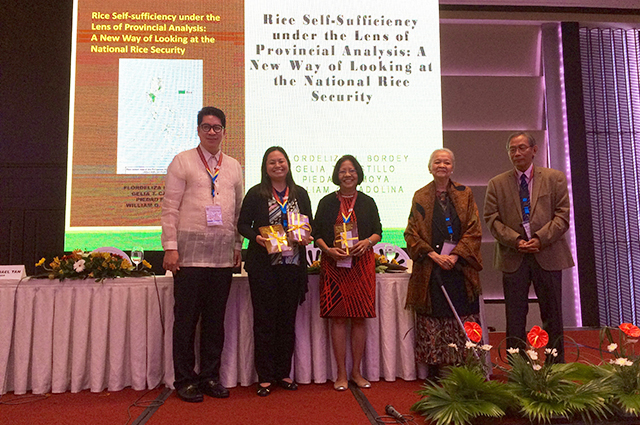 A book assessing the country’s provincial rice security was launched during the 38th National Academy of Science and Technology’s (NAST) annual scientific meeting at the Manila Hotel, July 13, 2016.
A book assessing the country’s provincial rice security was launched during the 38th National Academy of Science and Technology’s (NAST) annual scientific meeting at the Manila Hotel, July 13, 2016.
Titled Rice self-sufficiency under the lens of provincial analysis: A new way of looking at the national rice security, the book analyzes the provincial data on rice production, harvested area, and yield from 2000 to 2013 to assess provincial rice security status.
The authors are PhilRice’s Deputy Executive Director for Development Dr. Flordeliza H. Bordey; National Scientist, Gelia T. Castillo; former senior research manager of IRRI, Piedad F. Moya; and NAST President, William G. Padolina.
“The main message of this analysis is that provincial rice self-sufficiency depends not only on natural resource endowments, production, productivity, and harvested area but also on population size. The intended readers of this book are policy makers, gov’t planners from DA and its regional offices, and provincial planners,” Bordey said.
She added that the planners should consider provincial variability in planning for intervention to achieve sufficiency. Provinces with big rice areas and production should have different interventions from provinces that have smaller areas. This also applies to rice surplus and deficit provinces.
“In the national rice scenario, rice self-sufficiency depends not only on these factors but also on urbanization and the ability of rice-producing provinces to produce enough surpluses to cover the deficits of marginal and low rice-producing provinces but most of all, to meet the basic rice requirements of zero rice producing cities and urban centers,” Bordey explained.
For instance, the 17 non-rice producing cities in NCR with a combined population of roughly 13 M require about 1.2 M tons additional milled rice (about 1.8 M tons of palay). This exerts further pressure on surplus provinces to produce more.
The authors also advised the elected officials in the provinces to identify, nurture, and engage rice champions in their locality.
“Make it possible for everyone involved in this process from policy to planting rice to have the opportunity to deepen their knowledge and understanding of what it takes to grow a great crop of rice. Billions of persons alone are not likely to do the job. Money does not grow rice. People do,” the authors concluded.
The book is funded by NAST publications. Founded in 1976, NAST is the country’s highest advisory body to the government and the science community on matters related to science and technology.




